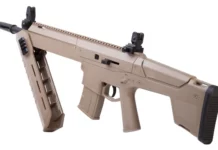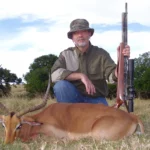Muzzleloaders are single-shot firearms that differ from modern weapons in that you have to load each round manually through the barrel. There are no rounds or casings, but you do use primers, powder, a slug, and wadding. The challenge of hunting with a muzzleloader is that you only have one shot, and you best have the skills, accuracy, and tenacity to make that one shot count.
Many states have muzzleloader seasons and those who love the thrill of the muzzleloader hunt. You can target birds, waterfowl, deer – white-tailed deer, antlerless deer, antlered deer, and even a black bear. You are pretty much talking accuracy at less than 100 yards and that means that a muzzleloader deer hunter is going to have to be fairly skilled at getting close to deer. You can check your state’s game agency to see if a muzzleloading hunting season exists for you.
Table of Contents
Why Hunt with a Muzzleloader?
Why not? There is a great challenge in hunting with a muzzleloader. For deer season, you have got to know the target – from antlered bucks to antlerless deer – you will need to get close, and that means growing as a hunter to understand the terrain. You’ll also need to understand the species of deer and improve your ability to stay unrecognized in the natural world. Plus, there is the challenge of being able to make a single shot count. It takes great skill to get close enough to deer to take them down without a modern weapon. Hunting with a muzzleloader includes:
The Traditional and challenging method of hunting – you’ve got to be accurate because you have only one shot. That means you have to know your prey, and the environment where you hunt, and have the skills to make your one shot pay off.They are Quieter and less expensive than modern firearms – Expect most muzzleloaders to fire in the 160-decibel range, which can be quieter than a modern rifle.Early deer hunting season for most states – the muzzleloader season generally starts earlier making it less crowded and the targets are not as aware. Some states, such as California, offer muzzleloader hunters events, and some have seasons where the events are mixed with archery. You still need a hunting license but leave the centerfire rifle at home.Do People Still Hunt with Muzzleloaders?
Muzzleloader hunting is an elite sport. It is a natural progression – in a backward fashion – and a spot for folks who are good at hunting to end up. It is one thing to take down deer or bears with a modern weapon. You can, after all, plink a few rounds off quickly even if you are not toting a semi-automatic. But the thrill of muzzleloading is not in just reaching your bag limit on a single afternoon. It is the challenge of being good enough at hunting to come home with game that you had to work at to get.
Muzzleloader Hunting vs Other Methods

Archery is perhaps the method of hunting that comes closest to muzzleloader hunting. That is purely because you have to be good enough at hunting to get close to your target. It is also a slower reload than other options.
Hunting with a modern rifle or handgun is much easier than hunting with a muzzleloader, simply because the second shot is much faster than with a muzzleloader. Modern rifles also have a longer and more accurate range, meaning that your hunting skills can be subpar, and you will still likely get a shot in even if it is a longer distance.
Make no mistake, skill is required for all of these options, but tracking, setting up stands, and stalking prey are a lot more difficult if you have to get within 100 yards of your target – and truthfully, more like 50-75 yards.
Regulations and Restrictions
Regulations vary by state. Many states offer muzzleloader events or seasons for hunters, especially those hunting deer and elk. Some events are populated drawings, and states like California often have better odds. It is important to check with your local hunting bureau to understand the regulations where you hunt and where you plan to hunt. Regulations also exist based on state and local laws, such as in California where you cannot hunt with lead bullets.
Muzzleloader Accuracy and Range

The distance that a muzzleloader can shoot accurately is a variable. Suffice it to say that with an old version of a muzzleloader, and all the stars aligned, you might hit a target 100 yards away. That’s a big “might.” Some modern inline muzzleloaders extend that range to 200 yards. Still, there is a lot between what can and what will happen.
Factors That Affect Muzzleloader Accuracy
Aiming – Don’t be surprised if part of your local regulations for muzzleloader hunting involves, or rather, restricts the use of modern sights such as scopes. Aiming the muzzleloader is one of the biggest issues with accuracy. You will need to dial in the type of sights (iron sights) on the muzzleloader.
Loads – Being able to pour a consistent load is important. Whether you are using black powder or smokeless powder, getting a consistent load will improve your accuracy. Too much powder, too little powder, not tamping down the bullet accurately, and other factors impact how well the bullet leaves the barrel. Flintlock or percussion cap muzzleloaders – sometimes called percussion cap rifles – will both have improved accuracy when you produce uniform loads and clean the fouling from the barrel.
Fouling – There is a lot of residue left around after you fire a bullet from a muzzleloader. Junior hunters can improve their accuracy by learning how to keep the barrel clean.
Barrel Length – Muzzleloaders come with a variety of lengths for barrels. Keep a consistent barrel length as this is one of the critical factors in rifles of all makes and models.
How to Improve Muzzleloader Accuracy
1. Shoot the gun as often as possible. Understanding its nature is one of the best ways of correcting accuracy issues that involve stress, fear, and other common shooting issues.
2. Practice loading the gun so that each load is as close to even as possible. Hunting with a muzzleloader is not the same as being in a war with one. Accurate loads mean the gun is less likely to foul and drop accuracy. This also means that you can reload faster without loading errors.
3. Cleaning the barrel – Make sure you can quickly and accurately clean the barrel. Being good at field cleaning the gun is essential because a clean barrel means you are back in the hunt.
Shot Placement and Effectiveness
You might be wondering where to aim when shooting a deer with a muzzleloader. When hit behind the front shoulder, your bullet travels across the shoulders, the heart, and the lungs. The angle of that shot will change based on your angle to the deer. Visualize that path and take your aim so that the bullet travels across the heart and lungs.
The best spot to shoot a deer with a muzzleloader is the heart. That is a deadly shot, and it is fairly instant.
How long do you wait after shooting a deer with a muzzleloader before going after it? The general rule of thumb is about half an hour. If you know that you have not mortally wounded the deer, then wait a few minutes. What you want to avoid is dealing with an injured animal that has the fight part of the flight or fight in place.
What are the 3 Types of Muzzleloaders?

Flintlock – A physical flint and steel powder ignition – the flint strikes the frizzen which causes damage to the frizzen and the spark ignites the powder.Percussion Cap – The cap sits over a nipple. When the hammer hits the cap, it causes the mercury-based “powder” to ignite.Inline Modern – the hammer hits either a cap or primer which then ignites the powder in the barrel.
Muzzleloader Maintenance and Safety
Make sure the muzzleloader is unloaded before you begin to clean the gun.
1. Cleaning the barrel is the biggest chore and one that everyone should be able to handle in the field.
2. Home cleaning can be more detailed including cleaning the breach plate or conduit from where the hammer hits and the ignition begins.
3. Use an approved muzzleloader solvent to clean the inside of the barrel. On inline muzzleloaders, you often shoot a copper-jacketed bullet with plastic sabots – those can be tricky to clean because the copper and plastic will cling.
Not all muzzleloaders have a safety. When they do make sure the safety works and then activate the safety before you begin to clean. Keeping your gun clean is one of the best ways to keep accuracy high.
Muzzleloader Bullets from Berry’s

To recap the benefits of hunting with a muzzleloader remember that hunting skills are repaid when every shot matters. Take the time to learn as hunting with a muzzleloader not only gives you more options for special hunts such as those for thinning button bucks, antlerless deer, hunting on public land or private hunting areas, and a field that has fewer hunters.
In the modern world, hunting successfully with a muzzleloader is a rite of passage. It means that you have to pair hunting skills, accuracy, and patience, plus your knowledge of the target, environment, and changing conditions.
Berry’s offers Blue Diamond 50 caliber 250-grain muzzleloader bullets with a polycarbonate tip and proprietary sabot. Expect a tight fit and improved accuracy with the Blue Diamond 50 Caliber, a 250-grain bullet designed for black powder muzzleloaders. The bullet is appropriate for loads designed for deer, and smaller game, such as feral pigs, and even larger game such as a black bear.











































